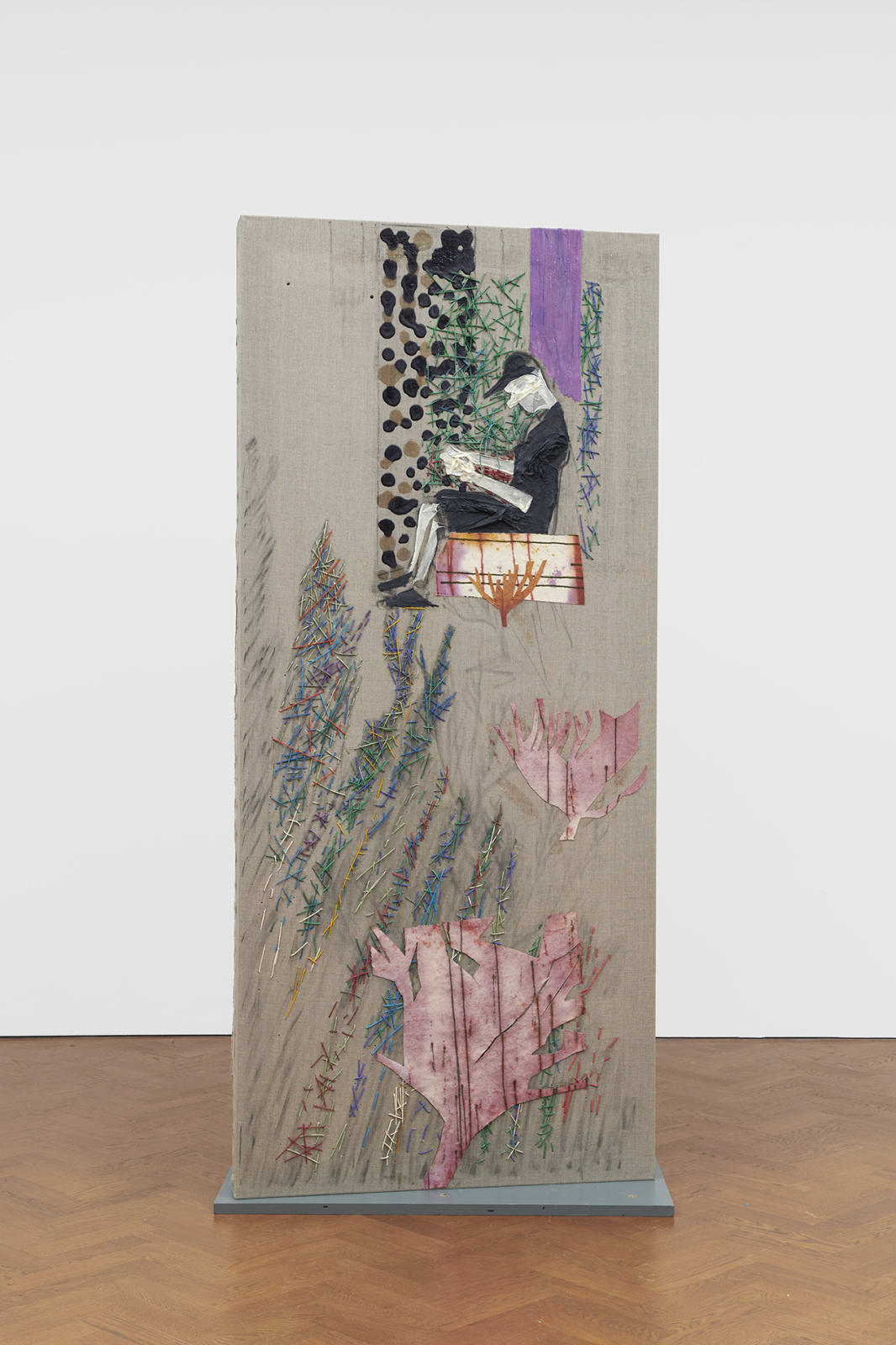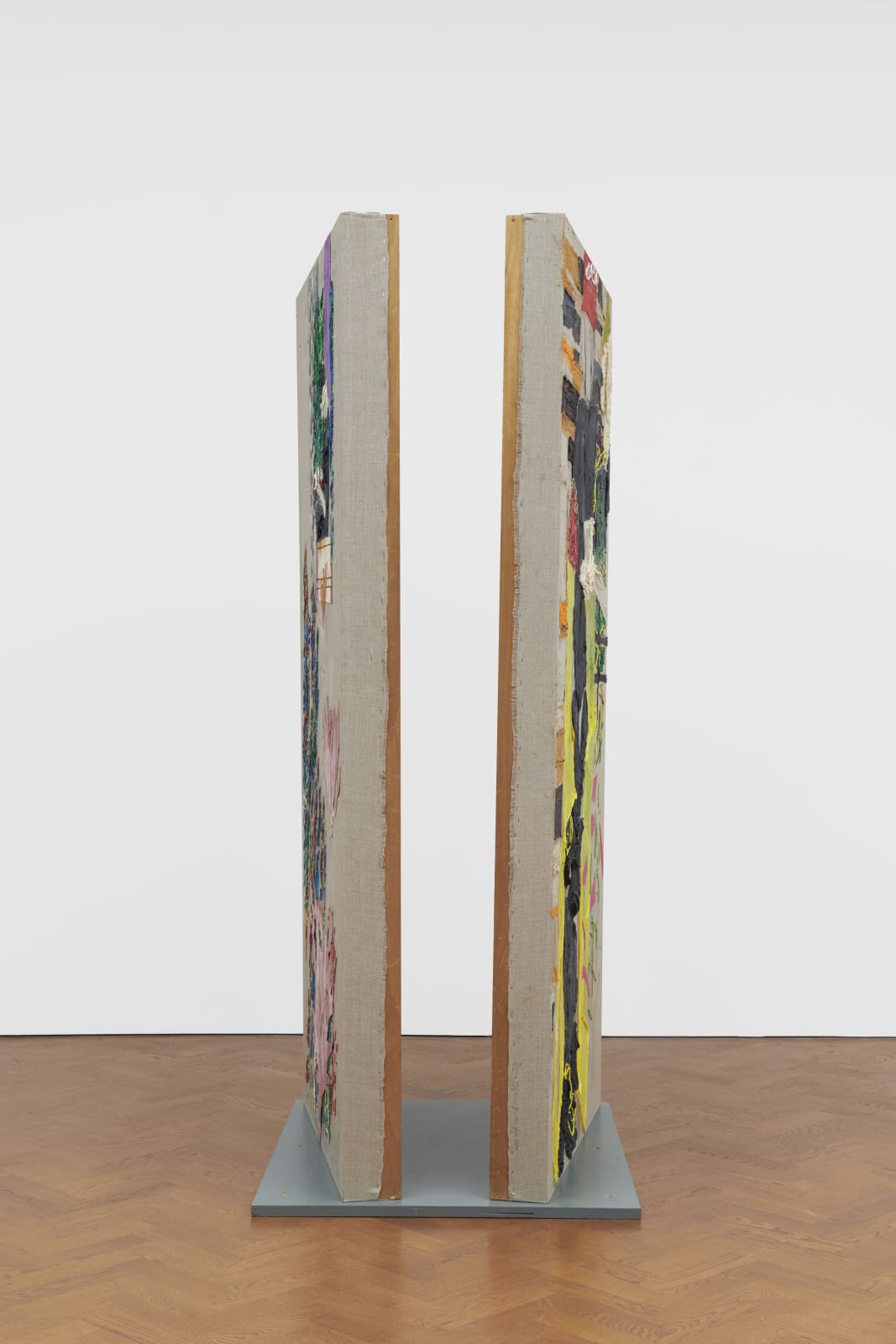Alvaro Barrington
In Three Americans and an Italian met on Montego Bay, 2020, Barrington references the American abstractionists Jackson Pollock (1912-1956), Barnett Newman (1905-1970) and Agnes Martin (1912-2004), while the Italian is Alberto Burri (1915-1995). The work's title is a play on the hackneyed joke format of 'three men walk into a bar…', but reimagined as a mythical meeting between these artists in Montego Bay, Jamaica - a signifier of Barrington's heritage. His use of burlap is linked both to Caribbean cacao sacks and Burri's burlap paintings, as well as the associated Arte Povera movement. The whorls of bleached lines evoke Pollock's drip painting technique, while the vertical division is a nod to Newman's 'zip' paintings. The sewn lines of black thread that frame the work pay homage to Martin's use of the line and the grid, motifs to which Barrington repeatedly returns.
Alvaro Barrington
Three Americans and an Italian met on Montego Bay, 2020
Mixed media on burlap paper
98 x 100.1 x 5.1cm (38.6 x 39.4 x 2 in)
In Dries Sept 2020, 2020, Barrington explores the intersections between fashion and fine art, referencing the Belgian designer Dries van Noten in a series of small-scale paintings that evoke the colour palette of his Fall 2020 menswear collection. Separated and contained within individual frames handmade by the artist, these become an emphatic meditation on each of the six different colour values, which are nonetheless inflected by the surrounding colours in the sequence. Strung in a line like jewels on a chain or ellipses in a sentence, there is a particular tempo to the arrangement of the individual works and the colour relationships they establish. In addition to referencing the world of fashion, this work is related to Barrington's ongoing exploration of the 'logic' found within other artists' works, which he adapts to and reinterprets in his own.
Alvaro Barrington
Dries Sept 2020, 2020
Mixed media on burlap paper in artist frame
21.6 x 27.9 cm (8.5 x 11 in) each
Mandy El-Sayegh
Mandy El-Sayegh presents an immersive installation that transforms the gallery's interior through a dense layering of her newsprint collage on the latex floor, overlaid with her Redaction Rug and surrounded by wall-hung paintings. In these works, El-Sayegh explores the production and circulation of images and texts, and the subjectivity of their interpretation, with a focus on language and the body.
In her Net-grid paintings, El-Sayegh overlays silkscreen prints combining personal memorabilia, found objects and linguistic elements with hand-painted grids to consider the proliferation of materials and information, as well as the structures that contain them. The painted grids function to simultaneously contain and obscure information. They suggest the cultural and linguistic dislocation experienced in an unfamiliar context or system, whereby fragments of information with no immediate associations are transformed through the illusion of unity.
The surface of Redaction Rug is both tactile and weathered, created using latex, newsprint, muslin and pigment, and layered with inked poetry. The piece began with a dust sheet, onto which two news articles were silkscreened; one concerning neoliberalism and the other sleep problems. Words are drawn out from these news articles and re-combined to create a 'bruise' poem - an archive of thoughts combinedwith ghosts of images. El-Sayegh refers to her collage process as 'suturing' and her use of latex evokes skin, so the metaphor of the body becomes a way of unifying and recontextualising these fragments.
Mandy El-Sayegh
Silkscreened ink and paper, cheesecloth, The Financial Times, wallpaper paste, latex
317 x 250 cm (124 3/4 x 98 3/8 in)
Rachel Jones
Jones is interested in creating images that explore the Black Interior, the depth of her own interiority and how, as a Black woman, it consists of an autonomous, imaginary, and multifaceted experience. This exploration of personal identity set against society’s readings (and representations) of Blackness throughout history has led Jones to develop a deeply personal approach to abstraction, whereby representation – particularly of Blackness and the Black body – is explored as both reinforcing existing power structures and as having the power to disrupt them.
A Slow Teething, 2022
Oil pastel, oil stick on canvas
186 x 264 cm (73.23 x 103.94 in)
A Slow Teething, 2022
Oil pastel, oil stick on canvas
155 x 190 cm (61.02 x 74.8 in)
Dona Nelson
Throughout her career, Dona Nelson has created gestural abstract works that employ unorthodox materials, processes and formats to disrupt conventional ideas concerning painting, modes of display and ways of looking. Painting ‘en plein air’, the artist approaches the canvas as both a conduit and a ground, using buckets of paint and tools such as spatulas or high pressure hoses to work on her canvases. Nelson begins her two-sided paintings by throwing a net of gel-soaked cheesecloth onto the canvas, which dries to form linear grooves that direct the flow of the liquid acrylic that she pours on, before repeating the process and then removing or adding elements in turn. The direct pour of diluted acrylic paint acquires a new and unexpected appearance as it soaks through the canvas to the other side. As a result, one side of the painting often has a denser materiality, while the other takes on an illusionistic and imagistic quality.
Dona Nelson
Orangey, 2015
Acrylic and acrylic medium on canvas (two-sided)
210.8 x 198.1 cm (83 x 78 in)
Ripped, layered and interwoven with painted string, Nelson's finished paintings bear testament to their production, retaining traces of the artist’s actions and the energetic, physical movements through which she produces each piece. Protruding cheesecloth, dense drips of paint and thickly woven string emerge and disappear into the canvas – the physical additions of the creative act – while torn edges and traces of cloth that has been removed take on a gestural absence – the creative act embodied in negative space. In By the Yard, 2016, the large, black-clad figure was modelled from life and is joined on the other side by a seated figure reading, a recurring motif in Nelson's work that was inspired by Paul Cézanne’s The Artist’s Father, Reading ‘L’Événement’ (1866).
Dona Nelson
By The Yard, 2016
Collage, dyed cheesecloth, muslin, acrylic mediums on linen panel, mounted on plywood base
210 x 81.1 x 94 cm (82.68 x 31.93 x 37.01 in)



























































































































































































